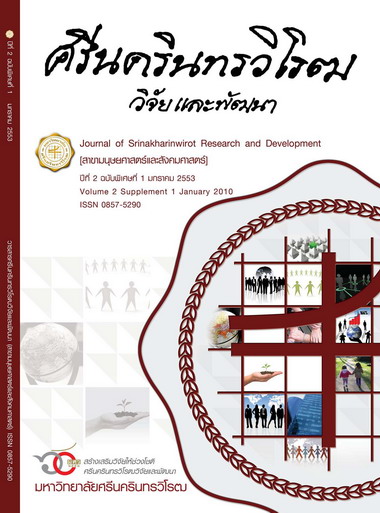โทรเวชกรรม: นวัตกรรมในการดูแลสุขภาพ (TELEMEDICINE: THE INNOVATION IN HEALTH CARE)
Keywords:
Telemedicine, Community Hospital, Primary Care Units, PolicyAbstract
บทคัดย่อ โทรเวชกรรมเป็นวิธีการใหม่ในโรงพยาบาลชุมชนไทยเพื่อใช้ในการเพิ่มประสิทธิภาพของระบบการดูแลสุขภาพผู้ป่วยที่สถานีอนามัยสามารถพบแพทย์ที่โรงพยาบาลชุมชนโดยไม่ต้องเดินทางไปที่โรงพยาบาลทั้งนี้จึงเป็นการประหยัดทั้งค่าใช้จ่ายในการเดินทางและเวลา วัตถุประสงค์ของการศึกษาเพื่อศึกษาความคิดเห็นของทุกฝ่ายที่เกี่ยวข้องในการบริการด้วยโทรเวชกรรมและนำไหสู่การวางนโยบายในอนาคต การศึกษาครั้งนี้อาศัยการวิจัยเชิงคุณภาพด้วยวิธีสัมภาษณ์ชิงลึก การสนทนากลุ่ม และการสัมภาษณ์ เป็นกลุ่มกับผู้มีส่วนเกี่ยวข้องกับการบริการโทรเวชกรรม ได้แก่ ประชากรตัวอย่างที่เคยใช้บริการโทรเวชกรรม ผู้ให้บริการโทรเวชกรรมของอำเภออ่าวลึก จังหวัดกระบี่ เจ้าหน้าที่จากหน่วยงานภาครัฐระดับชุมชน ระดับอำเภอและระดับจังหวัด ของจังหวัดกระบี่ และผู้ทรงคุณวุฒิด้านโทรเวชกรรมระดับประเทศ ข้อมูลที่ได้จากการศึกษาเชิงคุณภาพนำมากลั่นกรองและวิเคราะห์เนื้อหา ผลการศึกษาพบว่า ส่วนใหญ่มีความพึ่งพอใจและเล็งเห็นถึงประโยชน์ของการบริการโทรเวชกรรม ขณะเดียวกันบางรายมีความกังวลเกี่ยวกับการบริการนี้ การขาดนโยบายที่ชัดเจนจากกระทรวงสาธารณสุข และความสามารถในการให้บริการของเจ้าหน้าที่สถานีอนามัยที่จะปฏิบัติการตามคำสั่งของแพทย์จากโรงพยาบาล ด้านนโยบายโทรเวชกรรมในอนาคตควรมีหน่วยงานรับผิดชอบโดยตรงและหน่วยงานนั้นต้องมีนโยบายที่ชัดเจน ควรทำอย่างต่อเนื่อง ยั่งยืน และต้องมีการประสานงานของสถานีอนามัยและโรงพยาบาลชุมชน รวมถึงระบบในการจัดการสถานีอนามัยที่ดี การได้รับความร่วมมือจากทุกฝ่ายและการมีส่วนร่วมของชุมชนเป็นสิ่งที่ผลักดันให้ระบบบริการดังกล่าวประสบความสำเร็จได้ แนวนโยบายการบริการโทรเวชกรรมในประเทศไทยสามารถแบ่งเป็น 9 หมวด คือ 1) หน่วยงานที่รับผิดชอบ 2) กฎหมายและข้อกำหนด 3) รูปแบบ 4) ผู้ให้บริการ 5) ช่วงเวลาในการให้บริการ 6) ค่าตอบแทน 7) เวชภัณฑ์ 8) การประชาสัมพันธ์ 9) พัฒนาประสิทธิภาพและควบคุมคุณภาพ การศึกษาครั้งนี้สะท้อนให้เห็นว่าประกรไทยจะได้รับผลประโยชน์จาการเข้าถึงบริการโทรเวชกรรมเมื่อยามเจ็บไข้ได้ป่วยและผลประโยชน์เหล่านี้จะเกิดขึ้นได้ต้องได้รับการส่งเสริมจากนโยบายที่ดีและความร่วมมือที่เกี่ยวกับโทรเวชกรรม
Abstract
Telemedicine is a new approach recently introduced in Thai Community Hospitals (CH) to improve the efficiency of healthcare delivery systems. Primary Care Units (PCUs) can access doctors at CH, thus avoiding travel to the CH, and saving money and time. The objective of this study is to explore the situation and opinions of telemedicine stakeholders to further expand the benefits. The research method and data collection are qualitative, including in-depth interviews focus group discussions, and group interviews. The sample comprises patients using telemedicine, Ao Luek Hospital medical staffs and government officials at the community, district, provincial, and national levels. Qualitative data was analyzed by content. Results revealed that the majority of stakeholders are satisfied and aware of telemedicine practices. However, some have concerned about this service, such as a lack of clear policy from the Ministry of Public Health and the inability of PCU healthcare workers to follow the directions given by CH doctors. Therefore, for future policy, a single responsible agency should be established with clear, sustainable, and continuous practices that integrate PCUs and CH. Capacity building of primary healthcare providers should be organized better. Several government agencies, private sectors, and community groups with their traditional wisdom need to join together. Policy of telemedicine in Thailand could be divided into 9 categories as follows; 1) Responsible ministry 2) Law and legal provision 3) Models 4) Service providers 5) Duration of services 6) lncentives 7) Medical supplies 8) Public relations, and 9) Efficiency development and quality control. This study show that the Thai population will benefit when patients access telemedicine services and that those benefits can be enhanced further by good policy and cooperation.
Downloads
Downloads
Published
How to Cite
Issue
Section
License
Srinakharinwirot Research and Development Journal of Humanities and Social Sciences is licensed Under a Creative Commons Attribution-NonCommercial-NoDerivs 4.0 International (CC-BY-NC-ND 4.0) License, Unless Otherwise Stated. Please Read Journal Policies Page for More Information on Open Access, Copyright and Permissions.



